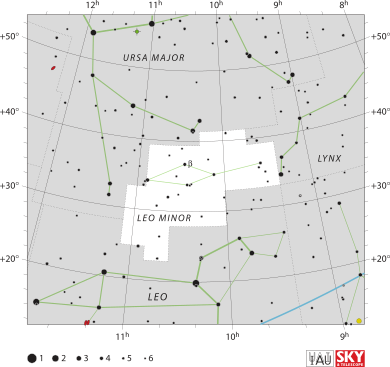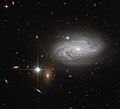Leo Minor facts for kids
| Constellation | |

List of stars in Leo Minor
|
|
| Abbreviation | LMi |
|---|---|
| Genitive | Leonis Minoris |
| Pronunciation | genitive |
| Symbolism | the lesser Lion |
| Right ascension | 9h 22.4m to 11h 06.5m |
| Declination | 22.84° to 41.43° |
| Quadrant | NQ2 |
| Area | 232 sq. deg. (64th) |
| Main stars | 3 |
| Bayer/Flamsteed stars |
34 |
| Stars with planets | 3 |
| Stars brighter than 3.00m | 0 |
| Stars within 10.00 pc (32.62 ly) | 0 |
| Brightest star | 46 LMi (Praecipua) (3.83m) |
| Messier objects | 0 |
| Meteor showers | Leonis Minorids |
| Bordering constellations |
Ursa Major Lynx Cancer (corner) Leo |
| Visible at latitudes between +90° and −45°. Best visible at 21:00 (9 p.m.) during the month of April. |
|
Leo Minor is a small constellation in the northern sky. Its name means "the lesser lion" in Latin. It is located between the much larger constellations of Ursa Major (the Great Bear) and Leo (the Lion).
Contents
What is Leo Minor?
Leo Minor is one of the 88 modern constellations that cover the entire sky. It's not one of the ancient constellations that people have known for thousands of years. Instead, it was created much later.
Who Discovered Leo Minor?
The constellation Leo Minor was first drawn on star maps by a Polish astronomer named Johannes Hevelius. He created it in the late 1600s. Hevelius wanted to fill in some empty spaces between the older, more famous constellations. He thought this area looked like a smaller lion.
Where Can You See It?
Leo Minor is in the northern sky. You can usually see it best in the month of April. It's located near other well-known constellations like Ursa Major, Lynx, and Leo.
Stars of Leo Minor
Leo Minor is not a very bright constellation. It doesn't have any super bright stars that stand out easily.
- The brightest star in Leo Minor is called 46 Leonis Minoris. It also has a special name, Praecipua, which means "the chief" or "the principal" in Latin. This star is a giant star, much bigger and brighter than our Sun.
- Another star, 11 Leonis Minoris, is one of the closest stars to Earth in this constellation. It's about 36.5 light-years away.
Deep-Sky Objects
Even though Leo Minor is small, it contains some interesting objects that are very far away. These are called deep-sky objects.
- One example is the spiral galaxy NGC 3021. A galaxy is a huge group of stars, gas, and dust held together by gravity. NGC 3021 is about 100 million light-years away from us. This means the light we see from it today started its journey 100 million years ago!
Meteor Showers
Sometimes, small pieces of space dust and rock called meteoroids enter Earth's atmosphere. When they burn up, they create streaks of light we call meteors or "shooting stars." If many meteors appear to come from the same area in the sky, it's called a meteor shower. Leo Minor is home to a minor meteor shower called the Leonis Minorids.
Images for kids
-
Spiral galaxy NGC 3021 which lies about 100 million light-years away.
See also
 In Spanish: Leo Minor para niños
In Spanish: Leo Minor para niños



